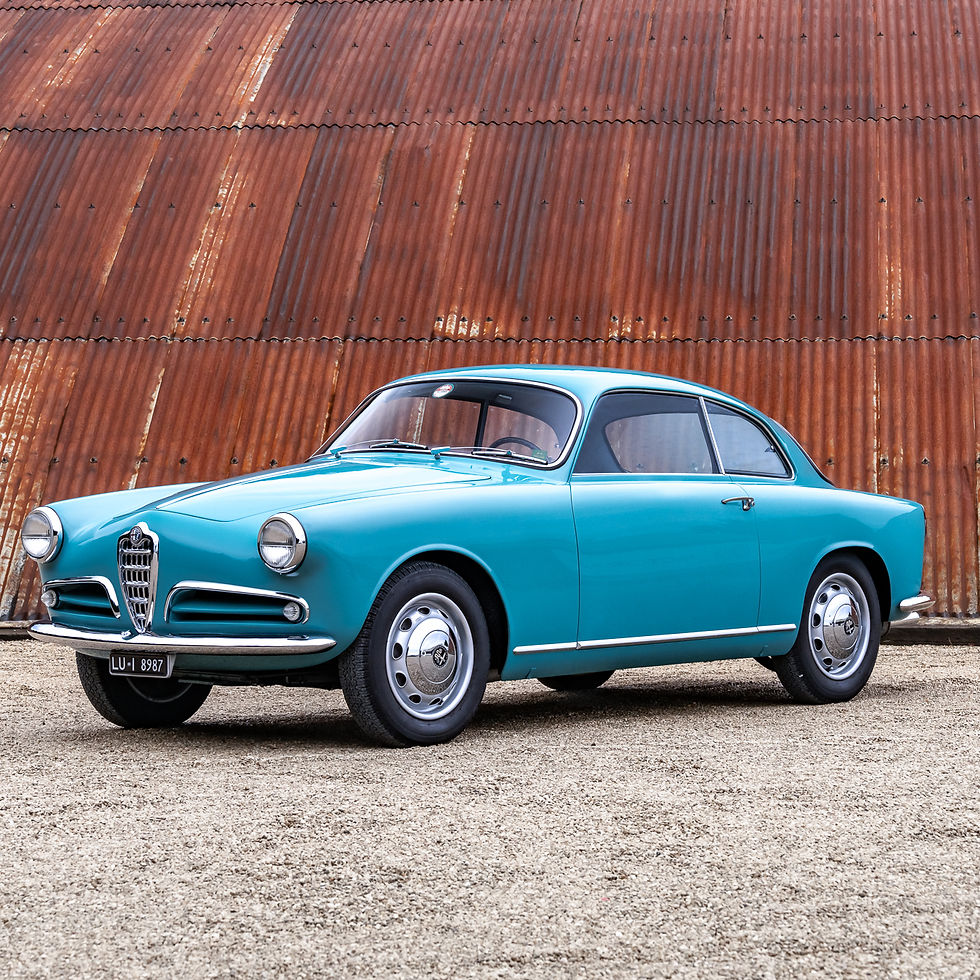The 330 America was replaced by the 330 GT 2+2, which was unveiled at the Brussels Motor Show. It was equipped with the new 209-type 4-litre V12, featuring a slightly longer engine block than that of the 400 SA series from which it was derived. The 330 GT 2+2, which was produced in two series, owed its elegant lines to Pininfarina. The main difference was in the front end, with the first series (1963-1965) featuring four headlamps and the second (1965-1967) just two. In all, around 1,000 examples were built.
Design
The 330 GT 2+2 Coupé made its debut at Ferrari's annual pre-season press conference in January 1964 before being unveiled to the public at the Brussels Motor Show later that month. It was the heir to the 250 GTE 2+2, the last series of which produced 100 models known as the 330 America: identical to the 250 GTE with a 4-litre engine.
Like its predecessor, this model took over the bodywork of the Pininfarina-designed 330 GT. It was slightly modified, however, and featured sloping twin headlights, with a 7-inch outer diameter and 5-inch inner diameter, reminiscent of the 400 Superamerica Superfast IV (chassis 2207SA). This gave the front end a somewhat American look, twin headlights being very fashionable across the Atlantic at the time.
The overall lines of the body were softer and more rounded, with the exception of the angular headlamp units, and the rounded rear section made it possible to offer a larger boot with horizontal rectangular monobloc rear lights following the curves of the wings. The wheelbase was 50 mm longer than that of the previous model, and the interior was reworked to offer rear passengers more legroom and headroom, without sacrificing the comfort of the front seats.
The Il series saw the bow modified in mid-1965. The double headlamps were replaced by single units, giving the front end a look very similar to that of the 275 GTS, which was produced at the same time. The Borrani spoke wheels (which had long been standard equipment on Ferraris) were replaced by 10-hole alloy wheels, still fitted with Rudge hubs, but still available as an option. On the front wings, the 14 slots of the 250 GTE were replaced by apertures, which were also used on the 275 GTS around the same time, while the front and rear bumpers were fitted with rubber-covered bumpers.
The interior was also redesigned: the floor-mounted pedals were replaced by a suspended unit, a central console was installed between the transmission tunnel and the lower edge of the dashboard, and the layout of the controls and ventilation was modified. The bodies were mounted on a 2,650mm wheelbase chassis bearing chassis number 571 (Series 1), then chassis number 571/65 (Series II). All chassis were numbered according to the odd-numbered sequence of Ferrari road cars, between 4,963 and 7,533 for Series I and between 7,537 and 10,195 for Series II.
The construction followed standard Ferrari practice at the time: large-diameter oval tubes with solid struts and substructures welded to the main frame to support the bodywork and ancillary equipment. This model was fitted with independent front suspension, a rigid rear axle with leaf springs and telescopic shock absorbers, four disc-brakes with separate front and rear hydraulic circuits and left or right-hand steering. Power steering was also offered as an option later in the production period.
The engine
The engine, a 4-litre V12, had a single overhead camshaft and was numbered 209, then 209/66. Its total displacement was 3,967 cc and its bore/stroke ratio was 77 x 71 mm. Spark plugs were located on the outside of the V and were accompanied by a row of three Weber 40 DCZ/6 or 40 DFI twin-barrel carburetors and a rear-mounted twin-coil distributor producing 300 bhp.
Based on Colombo's original 'short block' design, this engine was slightly longer with slightly larger bore diameters to facilitate water flow.
The difference in engine model type referred to the number of mounting points: four on the 209 and two on the 209/66, the latter being used from the
08729. The engine was coupled to a 4-speed synchromesh gearbox with an electronically controlled overdrive fifth gear on most l-series vehicles and to a 5-speed synchromesh gearbox on the latest l-series models and all lI-series models, with final drive provided by a driveshaft to the rigid rear axle. With the move from 4 to 5 speeds, the mechanical clutch control system has been replaced by a hydraulic system. The 330 GT 2+2 was produced from 1964 to 1967, before being replaced by the 365 GT 2+2. Over this period, 625 Series I and 474 Series II were produced, with sales exceeding those of the previous 250 GT 2+2 model over a similar production period. The 2+2 configuration proved very popular at the time.
The Ferrari 330 GT 2+2 Series II represents an exceptional combination of inspired performance, sophisticated Italian design and understated luxury. A refinement of the original 330 GT presented in 1964, the Series II features elegant Pininfarina bodywork with two headlights (instead of the four of the previous model). The engine was the same, with each model equipped with the attractive 4.0-litre 'Columbo' V-12 developing 296 bhp, while the five-speed manual gearbox was a new feature. Only 474 Series IIs were produced between 1965 and 1967.
Our car 1962 Ferrari 330 GT 2+2 SII #8175
Delivered new in Italy in January 1966 to Mr. PARODI, we find the car in the USA in the hands of its second owner, Mr. MACERI, at which time Borrani wire rims are fitted to the car. It was then sold to ATS of New England, and in 1992 the famous Italian collector Giuseppe PREVOSTI acquired it and brought it back to Europe. He kept the car in his famous collection for 16 years, taking the opportunity to have it restored by Sergio Rossi, a project that lasted 2 years.
It was when part of the collection was sold by RM Auction in LONDON in 2007 that its 4th owner, Mr BOUZOULOUK, acquired it.
The car was initially registered in England as FHJ 406D, before being sent to France with 154km on the clock since the end of its restoration and registered as 390RMC75 in 2009. The car will be used regularly by the latter and can be seen at numerous gatherings: The car is regularly serviced by Gilbert Tissier (Garage Super Sport). It was even the subject of a full report on Direct Auto, and was tested at length by François Allain, who had nothing but praise for it.
The current owner acquired the car in 2018. Entrusted to the good care of the SUPERSPORT workshop in Paley, in addition to regular maintenance, it should be noted that the engine and gearbox were completely rebuilt in 2019 at 23400km.
Even more recently, in April 2023 at 31639km, the entire braking system and shock absorbers were overhauled by Ets CAR in La Garenne Colombe.
Perfectly maintained, still equipped with its original engine and gearbox and presented in this elegant color combo as it left the Maranello factory, this Ferrari 330GT 2+2 Series 2 will delight its owner for long journeys or weekend breaks.


































































